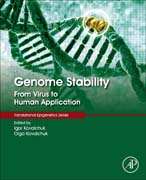
Genome Stability: From Virus to Human Application covers the genome stability of DNA/RNA viruses, prokaryotes, single cell eukaryotes, lower multicellular eukaryotes, and mammals, with the latter including major DNA repair mechanisms, the role of chromatin in genome stability, human diseases associated with genome instability, as well as changes in genome stability in response to aging. Every species has to preserve the integrity of its genome to ensure faithful passage of genetic information to the progeny. At the same time, there are times during the life of the organism and population in general when a fine balance in genome stability and diversification has to be made to benefit the survival of the species. This book teaches the reader how various species maintain this fine balance in genome stability and genome diversification in response to their environments. The book also covers how epigenetic factors contribute to genome stability and how species pass the memory of the encounters to the progeny, thus influencing the genome of the progeny in an indirect manner. Includes a collection of chapters on genome stability research from various kingdoms, including topics such as epigenetics and transgenerational effectsProvides the first comprehensive coverage of the differences in the mechanisms utilized by different organisms to maintain genomic stabilityContains applications of genome instability and its effect on human diseasesExplains how various species maintain the fine balance in genome stability and genome diversification in response to their environments INDICE: I. Instability of RNA and DNA virusesII. Bacterial genome instability1. General strategies for maintaining genome stability2. MMR3. GATC methylation/restriction4. CRISPR III. Genome instability of unicellular simple eukaryotes5. Genome instability of ciliates6. Genome stability in yeasts7. Genome stability in fungiIV. Genome stability in invertebrate animals8. Genome stability in Drosophila9. Genome stability in C. elegansV. Plant genome stabilityVI. Genome stability in mammals10. Chromatin and nuclear organization and genome stability11. Cell cycle control and DNA damage signalling12. Replication and postreplication repair13. BER/NER14. MMR15. DSB repair - NHEJ and HRVII. Specific mechanisms of DNA damage signaling and repair16. H2AX17. ATM1 signalling18. Role of p53/p16/p2219. Mitotic catastropheVIII. Human diseases associated with genome instability20. Genetic diseases - Xeroderma Pigmentosum, Cockayne syndrome, Fanconi Anemia, Njemigan breakage syndrome21. Cancer22. Cancer and genome instability23. The epigenetic regulation of cell cycle and DNA repair in cancerIX. Aging and genome instabilityX. The effect of environment and genome stability24. Diet and nutrition25. Chemical mutagenesis26. Radiation and DNA damageXI. Bystander and transgenerational effects27. Epigenetics of transgenerational genome instability in mammals28. Bystander effects in genome instability 29. Transgenerational genome instability in plants
- ISBN: 978-0-12-803309-8
- Editorial: Academic Press
- Encuadernacion: Cartoné
- Páginas: 700
- Fecha Publicación: 01/09/2016
- Nº Volúmenes: 1
- Idioma: Inglés
